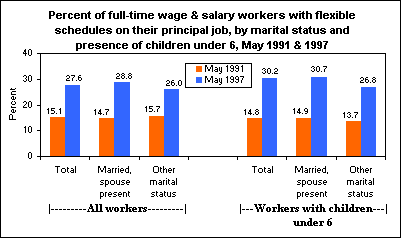An official website of the United States government
 United States Department of Labor
United States Department of Labor
From 1991 to 1997, the percent of full-time wage and salary workers with flexible work schedules on their principal job increased from 15.1 percent to 27.6 percent.

[Chart data—TXT]
Workers who were married with a spouse present were more likely to have flexible work schedules in 1997. Nearly 29 percent of such workers had flexible schedules, compared with 26 percent of workers who had another marital status. In 1991, married workers with a spouse present had a lower incidence of flexible schedules than workers with other marital status.
Workers with children under 6 years of age had an above-average incidence—over 30 percent—of flexible schedules in 1997. Nearly 31 percent of married workers with a spouse present and children under six had flexible schedules, compared with about 27 percent of workers with other marital status and children under 6.
These data are a product of the Current Population Survey program. Find out more in Chapter 3 of Report on the American Workforce 1999 (PDF 1,037K).
Bureau of Labor Statistics, U.S. Department of Labor, The Economics Daily, Incidence of flexible work schedules increases at https://www.bls.gov/opub/ted/1999/sept/wk5/art04.htm (visited April 18, 2024).

